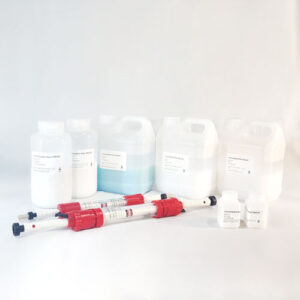Affinity Chromatography Agarose Beads
Agarose beads are the main matrix for affinity chromatography. The products are white suspensions not powder that keeps in 20% alcohol. Biovanix’s affinity chromatography agarose beads are specialized media used to purify targeted proteins of specific biomolecules, leveraging the power of affinity interactions.

- Precision Purification: Our affinity agarose media is designed for the highly specific capture of target biomolecules, based on their unique affinity interactions, ensuring a pure and concentrated product.
- Versatile Ligand Options: Compatible with a wide array of ligands, including antibodies, peptides, and small molecules, allowing for the customization of the purification process to fit specific biomolecular targets.
- High Binding Affinity: Offers exceptional binding affinity, which is crucial for the selective capture of even low-abundance proteins or other biomolecules of interest.
- Gentle Operation Conditions: The mild conditions required for binding and elution with our agarose media are ideal for preserving the integrity and bioactivity of sensitive biomolecules.
- Consistent Quality: Each batch of affinity agarose media is manufactured to the highest quality standards, ensuring consistent performance and reliable results.
- Scalability: Suitable for both small-scale research applications and large-scale industrial production, our media can be easily scaled to meet varying demands.
- Ease of Use: Simple to integrate into existing purification processes, our affinity agarose media streamlines the purification workflow, reducing complexity and enhancing efficiency.
The selection of agarose beads in affinity chromatography
|
Продукт |
Динамическая связывающая способность |
Приложение |
|
40 мг His/мл |
Высокая грузоподъемность Выделение и очистка рекомбинантных белков, меченных гистидином (His-Tag) |
|
|
40 мг His/мл |
||
|
50 мг His/мл |
Низкий уровень Ni2+ утечка Выделение и очистка рекомбинантных белков, меченных гистидином (His-Tag) |
|
|
50 мг His/мл |
||
|
25 мг His/мл |
В основном используется для разделения и очистки меченных гистидином (His-Tag) генно-инженерных белков, содержащих EDTA или DTT и другие компоненты. |
|
|
25 мг His/мл |
||
|
35 мг IgG/мл |
Аффинная очистка различных поликлональных и моноклональных антител |
|
|
50 мг IgG/мл |
Устойчивость к щелочам, легкая элюция Аффинная очистка различных поликлональных и моноклональных антител |
|
|
10 мг GST/мл |
Выделение и очистка белка, меченного глутатионтрансферазой (белок слияния GST), глутатионтрансферазы и глутатионзависимого белка |
|
|
1,5 мг АТ Ⅲ/мл |
Выделение и очистка АТ Ⅲ, фактора свертывания, липопротеина, липазы и полисахарида |
|
|
1,5 мг АТ Ⅲ/мл |
||
|
20 мг трипсина/мл (высокий суб) 10 мг трипсина/мл (низкий суб) |
Изолирование и очистка трипсина, тромбина, урокиназы, калликреина, прекалликреина и других сериновых протеаз |
|
|
25 мг БСА/мл |
Широко используется для разделения и очистки белков, особенно для удаления белка А из моноклональных антител, выделившихся через аффинную среду с белком А, а также димеров антител, белков хозяина, нуклеиновых кислот, вирусов. |
|
|
60 мг БСА/мл |
Широко используется для разделения и очистки белков |
Biovanix Prosep series is based on the Cytiva Capto series. It is a bioseparation medium developed for near-rigid cross-linked agarose microspheres. Prosep has nearly rigid physical properties, narrower microsphere distribution, more reasonable average particle size, and more protein adsorption space, which reflects higher adsorption capacity, lower chromatographic back pressure, higher operating flow rate and higher resolution in the chromatography process, and is a new generation of high-performance and cost-effective chromatography media. The ion exchange medium based on Prosep matrix has excellent performance and is widely used in laboratory scale preparation of biological macromolecules such as proteins, nucleic acids, peptides and polysaccharides, and large-scale industrial preparation of biopharmaceuticals and bioengineering.
|
Продукт |
Динамическая связывающая способность |
Приложение |
|
Просеп ММА |
20 мг БСА/мл |
Высокая жесткость Высокая скорость потока Высокое разрешение Быстрая загрузка |
|
35 мг БСА/мл |
||
|
60 мг lgG/mL |
||
|
45 мг БСА/мл |
||
| 35 мг БСА/мл | ||
| 50 мг БСА/мл |
Affinity Agarose Media
-
Среда для хроматографии на агарозе
Среда для хроматографии на агарозе Ni-TED 6HP
$1,000.00 В корзину -
Среда для хроматографии на агарозе
Среда для хроматографии на агарозе Ni-NTA 6HP
$1,000.00 В корзину -
Среда для хроматографии на агарозе
Среда для хроматографии на агарозе Ni-NTA 6FF
$1,000.00 В корзину -
Среда для хроматографии на агарозе
Среда для хроматографии на агарозе Ni-IDA 6HP
$1,000.00 В корзину
-
Среда для хроматографии на агарозе
Среда для хроматографии на агарозе с протеином А
$1,000.00 В корзину -
Среда для хроматографии на агарозе
Среда для агарозной хроматографии Prosep MabPure A LX Protein A
$1,000.00 В корзину
-
Среда для хроматографии на агарозе
Среда для агарозной хроматографии с бензамидином 4FF
$1,000.00 В корзину
-
Среда для хроматографии на агарозе
Среда для хроматографии на агарозе с гепарином 6HP
$1,000.00 В корзину -
Среда для хроматографии на агарозе
Среда для агарозной хроматографии с гепарином 6FF
$1,000.00 В корзину
-
Среда для хроматографии на агарозе
Среда для хроматографии MMA HPR Prosep Agarose
$1,000.00 В корзину
-
Среда для хроматографии на агарозе
Среда для хроматографии MMC HPR(LS) Prosep Agarose
$1,000.00 В корзину -
Среда для хроматографии на агарозе
Среда для хроматографии MMC HPR(HS) Prosep Agarose
$1,000.00 В корзину
Document Download
Product Manual Ni-IDA
Product Manual Ni-IDA 6FF
Product Manual Ni-IDA 6HP
Product Manual Ni-NTA
Product Manual Ni-NTA 6FF
Product Manual Ni-NTA 6HP
Product Manual Ni-TED
Product Manual Ni-TED 6FF
Product Manual Ni-TED 6HP
Product Manual Protein G 4FF
Product Manual Protein G 4FF
Product Manual Protein A 4FF
Product Manual Protein A 4FF
Product Manual GSH 4FF
Product Manual GSH 4FF
Product Manual Benzamidine 4FF
Product Manual Benzamidine 4FF
Product Manual Heparin
Product Manual Heparin 6FF
Product Manual Heparin 6HP
Product Manual MMA
Product Manual MMA 6FF
Product Manual Prosep MMA HPR
Product Manual MMC
Product Manual Prosep MMC
Product Manual Prosep MMC HPR (LS)
Product Manual Prosep MMC HPR (HS)
Product Manual Prosep MabPure A LX
Product Manual Prosep MabPure A LX
MSDS For Agarose Chromatography Resin
MSDS For Agarose Chromatography Resin
The Advantages Of Agarose Gel Beads
Agarose gel beads are widely used in affinity chromatography, and their main advantages include:
- Biocompatibility: Agarose is a natural polysaccharide that has good biocompatibility and is less likely to cause denaturation or loss of activity of biomolecules.
- High Porosity: Agarose beads have high porosity, which helps to improve the mass transfer efficiency in the chromatographic process, thereby enhancing the separation efficiency.
- Chemical Stability: Agarose beads are stable over a wide pH range, allowing them to be used in different buffer systems.
- Good Mechanical Strength: Agarose beads possess a certain level of mechanical strength, enabling their use under high flow rates, which is beneficial for increasing production efficiency and reducing costs.
- Easy Functionalization: Agarose can be functionalized through various chemical reactions, facilitating the introduction of affinity ligands, such as protein A, for the purification of specific proteins.
- Cost-Effective: Compared to other types of matrices, agarose is generally less expensive, making it more attractive for industrial-scale chromatographic applications.
- Low non-specific Adsorption: Agarose beads typically have low non-specific adsorption, which helps to reduce impurities in the sample and improve the selectivity of the purification process.
- Reusable: With proper regeneration and cleaning, agarose beads can be reused multiple times, helping to reduce the cost of the purification process.
- Environmentally Friendly: Since agarose is biodegradable, the chromatographic process using agarose beads has a smaller environmental impact.
How to choose the media of affinity chromatography
When selecting affinity chromatography packing materials, several key factors should be considered to ensure that the packing is suitable for specific separation needs. Here are some factors to consider when choosing affinity chromatography packing materials:
- Target Molecule Characteristics: First, consider the size, charge, hydrophobicity, and other biochemical properties of the target molecule, as these will affect its interaction with the packing material.
- Physical and Chemical Stability of the Packing: The packing should have good mechanical and chemical stability to withstand the pressures and different chemical environments of the chromatographic process.
- Porosity and Surface Area: High porosity and a large surface area contribute to improved mass transfer efficiency and target molecule binding capacity.
- Biocompatibility: The packing should have good biocompatibility to minimize non-specific adsorption and denaturation of the target molecule.
- Choice of Affinity Ligand: The affinity ligand should have high specificity and affinity to effectively capture the target molecule. Common affinity ligands include antibodies, protein A, metal ion chelators, lectins, and dyes.
- Cost-Effectiveness: The cost of the packing material is also an important factor, especially in large-scale purification processes.
- Regeneration and Reusability: Ideal packing materials should be capable of being reused over multiple purification cycles without losing performance.
- Flow Rate and Resolution: The packing should allow for rapid flow while maintaining good resolution to effectively separate the target molecule.
- Compatibility: The packing should be compatible with the chromatography system used, including compatibility with the mobile phase and detection systems.
According to the search results, agarose packing materials have become popular in affinity chromatography due to their low cost, large pore size, low non-specific binding, and broad pH stability. However, agarose has limited mechanical stability at high operating pressures, which may limit its use in high-performance liquid chromatography (HPLC) systems. Other carbohydrate-based materials, such as cellulose, have also been used as supports in affinity chromatography, although they were more common in early affinity chromatography applications and are now often used in membrane-based affinity separations.


